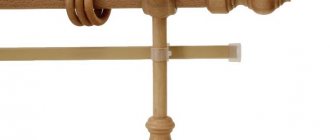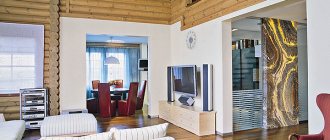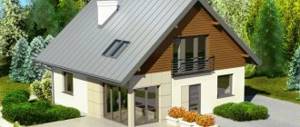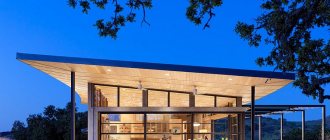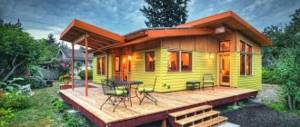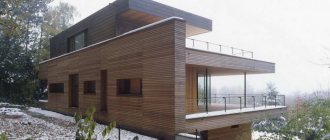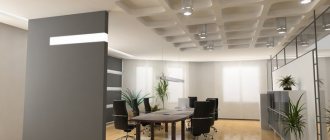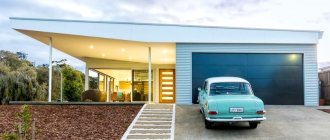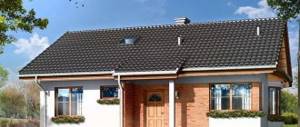3464
From this article you will learn:
- What are the advantages and disadvantages of wooden houses
- What are the advantages of wooden houses made of various materials?
- What are the advantages of hand-cut wooden houses and houses made of rounded logs?
Wood is a natural building material, the demand for which will never fall. They started building from wood many centuries ago, but the fact that we still use classical construction technologies to this day is not a tribute to fashion. This approach is primarily optimal for building your own home. Let's take a detailed look at all the advantages of wooden houses in our article today.
Wooden house made of timber
Regular timber with a rectangular cross-section and natural moisture content is one of the cheapest wooden wall materials. A thin beam of 100x100 mm “leads” strongly, and in order to create stiffening ribs every 4 meters it requires bandaging, limiting the area of the rooms to 4x4 m. For this reason, it is more often used for the construction of country houses. From thicker timber 200x200 mm, houses of any size are built for permanent residence.
Pros:
- lowest price - ease of work - environmental friendliness
Minuses:
- the need to shrink the log house for up to 1 year increases the construction time - cracks appear when drying - the surface of the walls is uneven (tolerance ±0.5 cm in thickness) - the complexity of finishing - the crowns and inter-crown seams have to be insulated (the labor intensity of construction increases by 1.5 times) - high airflow of the profile and cups - the need for finishing with additional materials
Wooden log houses
When building such houses, rectangular specially dried timber or material with natural moisture is used. Most often, thin timber is used for the construction of small country houses due to limitations in the area of rooms.
Thick timber is used in the construction of houses for permanent residence.
Timber construction today is one of the popular methods of inexpensive construction of low-rise buildings.
Advantages:
| Flaws:
|
Houses made of profiled timber
Profiled timber (not to be confused with laminated veneer lumber) is, in fact, the same ordinary timber of rectangular cross-section, only it has tenons and grooves on the upper and lower surfaces. This type of timber can be dry and naturally moist, but the dry version is almost never offered on the domestic market, since it “leaks” greatly during artificial drying.
Pros:
- relatively low price - tight, windproof connection of timber in the walls (thanks to tenons and grooves) - fewer cracks during shrinkage, unlike conventional timber - environmental friendliness
Minuses:
- the need for shrinkage of the log house for up to 1 year increases the construction time - when drying, cracks appear on the front side - as a rule, only one side of the timber is planed, which leads to problems with finishing - dry timber is significantly more expensive than timber with natural moisture - high airflow of the cups - the need for additional finishing materials
Log construction
Unlike the construction of frame houses, log huts have been built in our country since ancient times. Logs remain a popular material to this day. Houses built from this type of wood have a special internal microclimate. They are cozy, warm in winter and cool in summer, they are reliable and beautiful. There are two types of logs - rounded and hand-processed.
Rounded log
Wood rounding is carried out at the factory. The lumber is smoothed, equipped with joining elements and insulation. A house from this material can be simply assembled, like a construction set. The main advantage of such buildings is their low cost: the price is almost a third less than houses made of hand-hewn logs. This is explained by the fact that all labor-intensive work is carried out at the production stage. There are a number of other advantages:
- fast and accurate assembly;
- attractive appearance;
- environmental friendliness.
Flaws:
- A rounded log does not have an outer protective layer. It is necessary to apply special protective varnishes and paints;
- the likelihood of cracks appearing on the outside;
- restrictions when choosing interior design;
- difficulties with finishing.
When building frame houses in regions with a dry climate, such logs, after special impregnation, are used for the foundation.
Houses made from hand-hewn logs
The material is processed manually. This job requires special skills. The process is labor-intensive, long and expensive. However, the result is worth it. The material is environmentally friendly, durable, beautiful and has excellent thermal insulation properties.
Advantages:
- manual processing allows you to preserve the outer resinous layer. Which provides the wood with additional protection;
- the beauty of natural wood is preserved;
- the material is impeccable from an environmental point of view.
Flaws:
- high cost of construction;
- The log will have to dry for a couple of years;
- since logs require shrinkage, construction time increases noticeably;
- processing logs requires professionals, who are not so easy to find;
- difficulties with finishing.
Hand-hewn log houses
Logs of this type are processed manually, i.e. the bark is removed from them with an ax and a hand scraper. This is a wall material of natural moisture from pine, larch or cedar.
Pros:
- manual processing allows you to leave an outer, resinous layer on the surface of the logs, protecting the structure from atmospheric influences - environmental friendliness - houses are not inferior in appearance to structures assembled from rounded logs - looks beautiful and exclusive for specific buildings
Minuses:
- relatively high cost of construction - takes a very long time to dry (a pine log with a diameter of 32 cm dries in 1.5-2 years, and from larch - 5-7 years) - the need for many years of shrinkage of the log house seriously increases the construction time - the log house can only be built by specialists, such as very little - complexity of finishing
Houses made of rounded logs
A rounded log is made from an ordinary log by grinding on special woodworking equipment to obtain a uniform diameter along the entire length. There are two types of rounded logs: regular and profiled. In the first case, the log has a semicircular groove for a tighter fit to the lower log, and in the second, the log has a spike on top and a groove at the bottom. This is the most competitive material in relation to laminated timber.
Pros:
- the price is lower than that of hand-cut logs (on average 30% cheaper) - high speed and accuracy of wall assembly, respectively, less labor intensity - aesthetic appearance - environmental friendliness
Minuses:
- does not have an outer protective layer - when drying, cracks may appear on the front side - there are restrictions on the choice of interior, problems with furniture, installation of household appliances, which ultimately leads to an increase in the cost of the house as a whole - complexity of finishing
Houses made of wood, which one to choose and what is the price
Houses made of wood, which one to choose and what is the price? Information sources have recently increasingly offered services for the construction of wooden houses. The popularity of wooden houses is growing at lightning speed. The price of a finished house differs depending on what the house will be made from and using what technology. In this article we will try to understand the pros and cons of wooden houses. From what, and how, is this or that type of house built? Why does the cost of building a house using different technologies from different materials differ markedly from each other? And does it mean that if the cost is cheaper, then the house is worse? Let's figure it out.
Also interesting:
Thermoabash and its properties
Currently, the construction market generally distinguishes four types of houses, which are built in different ways:
- -according to frame technology
- - made of timber
- - made from solid wood logs
- - made of laminated wood beams
In general, all types of wooden houses have a huge advantage. This is natural!
It has been scientifically proven that people who live in wooden houses for years suffer practically no or less often from headaches, migraines, and depression.
- The first type of house that we will analyze is one whose basis is a frame made of wooden beams.
The house is wooden, the builders call it “Frame”. This is the most “budget” type of house of all those on the market. The name of the house speaks for itself. The basis of the house is the frame. The frame is made of timber. The cladding or “shield” of the frame is usually made of either plasterboard or lining. Insulation is installed inside such a shield. In Russia, the cost of building one square meter of such a house varies. And it is about 6.5-10.5 thousand rubles/sq.m. Such a house will “grow” on your site very quickly. This is the most rapidly erected type of house of all types that are currently on the market.
- The second type of house is made entirely of wooden beams.
Houses made of wooden beams are “assembled” like a children’s construction set. A groove is cut out in the beam, and the beam is placed one on one in this groove. From a design perspective, this is not the best type of home to choose. Firstly, the house shrinks vertically after a year or two, so the construction time for such a house cannot be fast. Even if they build it for you quickly, then in a year or two you will notice that the house is “creeping”. Moreover, the drying of the tree may be uneven. Over time, a large number of cracks often appear on the timber, due to the fact that for the most part in Russia the timber is made not according to GOST, but handicraft. The worse the timber, the more cracks appear on the house. Because of this, after a couple of years, the timber will have to be treated with deep impregnation on both sides. Judging by the reviews of the owners, this is not the best type of wooden house to choose. And the cost of construction on the market is already about 10.5 thousand rubles -12.5 thousand rubles. for 1 sq.m
- The third type of house we are considering is a real “log” house.
This type of house, as the name implies, is built exclusively from solid logs. These houses are “from the past.” Previously, our ancestors built houses from logs.
The strength, durability, and massiveness of such a house will be the envy of any other wooden house. To build a house, logs with a diameter of 18 to 26 mm are used. A house made of solid logs will retain heat very well. In hot weather the house will not be cool, in cold weather it will be warm. Accordingly, the cost of building such a turnkey house will not be the lowest among wooden houses. On average in Russia, the cost for construction of 1 sq.m is 12.5 thousand rubles - 14.5 thousand rubles.
- The fourth type of house, the final one in our article, is a house made of laminated timber.
Glued laminated timber was “invented” and began to be used only about forty years ago. The roots of the “invention” grow from Finland. Houses made from glued beams are often called Finnish, precisely because this is the birthplace of this material.
Glued laminated timber gives minimal shrinkage. Thanks to the manufacturing method, the glue beam is not susceptible to damage by microorganisms that can destroy the wood. The glue beam is not prone to rotting. The timber is manufactured with an ideal, stable, geometric shape.
The advantages of houses made of laminated veneer lumber can be listed endlessly. This is the best option for building a house made of wood. After construction, the house will not “extract” money for any “finishing” or eliminating imperfections. But the cost of construction is the most expensive, but, as you know, “The miser pays twice.” The price on the market for 1 sq.m of a house made of laminated timber is 26.5 thousand rubles - 30.5 thousand rubles.
The choice is yours.
Share your opinion or choice of wooden house in the comments.
Subscribe to our Yandex.Zen channel
You might be interested
- 12/10/2018 International construction and interior exhibition BATIMAT RUSSIA
- 12/05/2018 Bathroom without tiles. 8 options.
- 12/07/2018 Where did stretch ceilings come from?
- 12/02/2018 Wallpaper without wallpaper. DIY decorative wall decoration step by step.
- 12/03/2018 Linden. Properties of wood. Beneficial features
Frame wooden houses
Frame wooden houses are conventionally divided into two main types: frame and panel. In the first case, a frame is first constructed from laminated veneer lumber, then it is sheathed and insulated. In the second, houses are built from sandwich wall panels or a frame is first assembled from factory-made frames and then sheathed.
Pros:
- low price - fast delivery of house elements by road - quick assembly (saving on extra man-hours and equipment work) - the ability to further reduce the price by choosing a standard project
Cons (mainly related to panel technology):
- cheap sandwich panels contain polystyrene foam - multilayer “eco-friendly” panels are expensive - a truck crane is required for construction - in small areas it is difficult to find a place to store panels - high cost of finishing
Houses made of glued profiled timber.
Glued laminated profiled timber is produced using original technology, which involves sawing round timber into boards, drying them to a moisture content of 8-12%, sorting and gluing into timber on a powerful press. For the last operation, a special environmentally friendly, high-strength waterproof glue is used. The resulting beam is profiled to create a tongue-and-groove joint, then the crown cups are cut into it and technological holes are drilled for the tie rods.
Pros:- fast delivery and assembly of the house - does not require shrinkage - smooth wall surfaces do not require additional finishing - durability (100 years of service for such a house is not the limit) - complete environmental friendliness - the walls have good air and vapor permeability - the ability to implement any projects in terms of area and according to the layout - beauty and aesthetics - tight connection of beam profiles and cups |


